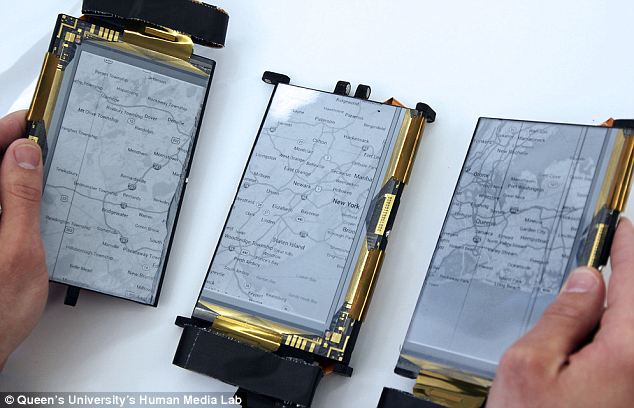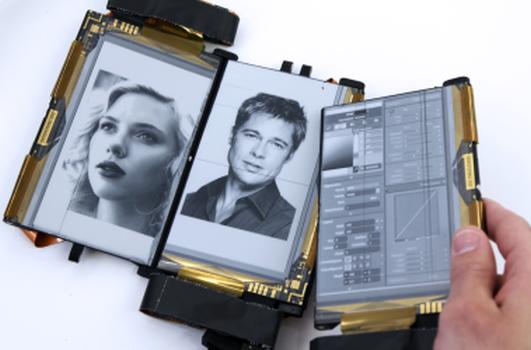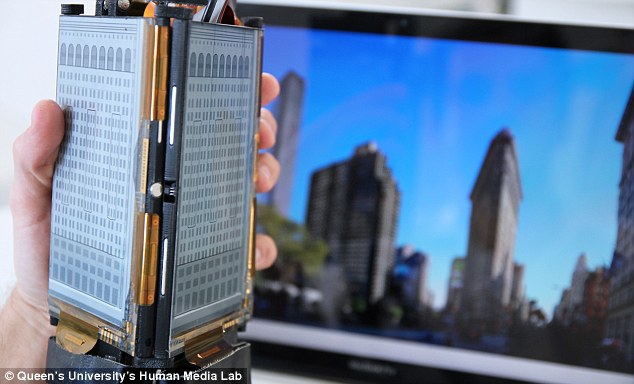[VIDEO] A Foldable Smartphone With Three Detachable Screens That Can 3D Print A 'Building'
While it can make calls, send messages and access the internet, it also has another trick: three screens that can fold together or detach from one another for a variety of configurations.
The Human Media Lab at Queen's University has taken the wraps off its new prototype smartphone that's flexible and modular. It's called 'PaperFold'.
Each screen, pictured, can be removed so users can fold the device into various shapes that range from a notebook shape to a foldout map. It automatically recognises its shape and changes its graphics to provide different functionality upon shape changes
Image via dailymail.co.ukThe PaperFold lets users fold open up to three flexible electrophoretic displays to provide extra screen real estate when needed. Displays are detachable such that users can fold the device into various shapes that can range from an ultra notebook shape to a fold-out map.
With this device comes a set of three e-ink displays, which are attached together with magnets. When combined, they work together as part of a single system, but can also function individually, and in multiple shape arrangements.
slashgear.comPaperFold can be made smaller for texting, or larger for reading maps, and can even be turned into a laptop
The idea behind the smartphone is fairly simple: adding displays gives users extra screen space for times that call for it, whether it is looking at information while chatting, seeing a map spread out across the table, or arranging the smartphone into a laptop-like shape.
dailymail.co.ukAdditionally, folding the PaperFold into the shape of a building from Google's 3D flyover maps picks up a Google SketchUp model that's available for 3D-printing
Elsewhere, shaping PaperFold into a convex globe shows the map in Google Earth view, while putting PaperFold into the shape of a 3D building when viewing a map, pictured, will pick up a Google SketchUp model of the building and turn the device into an model that can be 3D printed
Image via dailymail.co.ukWhen displaying Google Maps, the map can be displayed over three displays when folded flat like a paper map. By folding the map into a convex globe shape, the view dynamically switches to Google Earth view. Further folding so that the shape of the device resembles that of a building on the map switches the view to a 3D SketchUp model of the displayed building ready to be sent to a 3D printer.
"In PaperFold, each display tile can act independently or as part of a single system," said Dr Vertegaal, a professor in the School of Computing and Director of the Human Media Lab. "It allows multiple device form factors, providing support for mobile tasks that require large screen real estate or keyboards on demand, while retaining an ultra-compact, ultra-thin and lightweight form factor."
The phone can automatically recognise its configuration and change how it displays information based on that configuration
For example, folding the device into a notebook shape opens up a keyboard on the bottom screen. PaperFold owners could use this to create documents, or type an address search on Google Maps displayed on the top screen, pictured
Image via dailymail.co.ukFor example, opening it up like a notebook changes the bottom display into a keyboard for typing — to perform web searches. Other configurations include flattening, which opens a Google map view across all three flattened screens; folding into the shape of a building, which will display the Google SketchUp model of the building that can be 3D printed; or, viewing an album of thumbnails, flipping the right side up and down will flip through the thumbnails shown on the left in full-screen.
PaperFold is only a prototype at the moment and the researchers have not revealed details about whether it will go on sale commercially
The HML's director, Dr. Vertegaal, explained that his team is looking after modelling the versatile qualities of traditional paper into electronic devices. "PaperFold demonstrates how form could equal function in malleable mobile devices." - explained the scientist. Although it's in its early stages, the technology definitely shows a promising start. If anything, perhaps foldable e-ink displays will completely replace newspapers someday.



